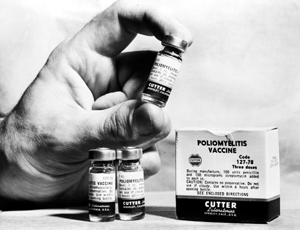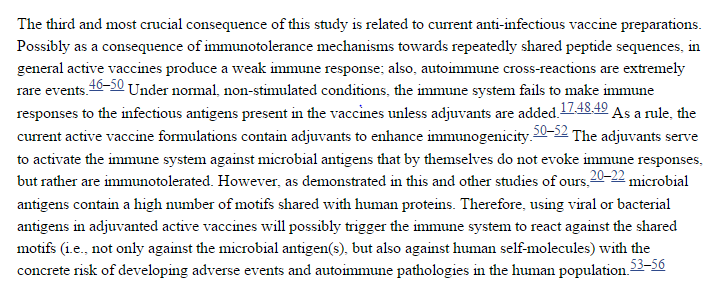January 21, 2016
 “The conception that antibodies, which should protect against disease, are also responsible for disease, sounds at first absurd.” — Clemens von Pirquet, 1906
“The conception that antibodies, which should protect against disease, are also responsible for disease, sounds at first absurd.” — Clemens von Pirquet, 1906
A while back I wrote a blog stating that, while my own views on vaccines could be considered extreme (I had come to the conclusion that vaccines are not a good idea for anyone), I was very grateful for those whose concerns were much more lukewarm as long as they were willing to express them publicly. In that blog, I didn’t go into the reasons why I had come to that particular conclusion and expressly stated that it was my own opinion based upon years of reading the science behind the interaction of the immune system and injected vaccines. I always had it in the back of my mind to go into the thought processes that brought me to this conclusion, but somehow I never got around to it. When two very new peer-reviewed scientific papers on autoimmunity and vaccines came to my attention, however, I found myself feeling the need to provide at least the bare outlines of how I came to this opinion.
Immune System Basics
The first thing to understand is how our bodies fight off infection, what we call the “immune system.” Our bodies have a number of ways of clearing itself of organisms that are potentially harmful. The first line of defense is the skin which keeps out the vast majority of pathogens that we encounter on a daily basis. When a pathogen gets past the skin by entering the lungs or digestive system through the nose or mouth, the body throws an obvious inflammatory response. This may be the production of mucus in the nose or lungs, the classic stuffy nose and cough. This inflammatory response is enough for a number of invaders, such as the rhinovirus which results in the classic cold. (Note that the symptoms of a cold that make us feel “sick” do not result from the virus itself, but from the immune system’s response to the invader.)
For others, such as norovirus, one of the viruses behind “food poisoning,” the response is vomiting and diarrhea in order to more forcibly eject the virus from the body. And for others, like measles and chicken pox, fever and rashes are caused by the body’s attempts to rid itself of the virus. It’s very important that the immune system be capable of mounting these inflammatory defenses in order to keep the body intact and working well.
 When an infection happens, though, the immune system has another set of tools, an invisible chemical set, that also get to work in an attempt to neutralize the offending invaders. Generalized or “cell-mediated” chemical defenders jump in first. This includes cytokines, white blood cells, and macrophages.
When an infection happens, though, the immune system has another set of tools, an invisible chemical set, that also get to work in an attempt to neutralize the offending invaders. Generalized or “cell-mediated” chemical defenders jump in first. This includes cytokines, white blood cells, and macrophages.
The last line of defense is the “humoral” defense, antigen-specific antibodies. Few of the pathogens we encounter would ever naturally stimulate antibody production because few get this far. I don’t know about you, but I was taught in high school biology that antibodies were like locks and keys. A specific antibody could “unlock” only one type of antigen. When the immune system figured out how to “unlock” a particular invader, it produced more and more “keys” that would kill off that invader completely.
It turns out that is a vast oversimplification of how antibodies work.
The Humoral Immune System and the Production of Antibodies
There are five types of antibodies, and the different types accomplish different goals. There are antibodies that are designed to be more generalized defenders such as IgM, a type that babies are generally born being able to produce in low quantities. And there are antibodies that are designed to be more specific attackers, with the most specific being IgG antibodies. These are considered “high-affinity” antibodies, and the ability to produce this type of antibody develops slowly in children, not reaching mature levels until around the age of five. Even these antibodies are not the true “lock and key” that I was taught in high school, however.
Everyone knows (or at least they should) that the idea behind vaccines is to stimulate production of antibodies against a particular disease or diseases. On the surface it’s a great idea: stimulate production of antibodies that “unlock” the disease even before the body can mount an inflammatory response that makes you feel “sick.” Then you don’t have to get sick!
It all began with the smallpox vaccine, which was used before anyone knew what viruses or antibodies were. The interesting thing about the smallpox vaccine is, it is itself an illustration of how oversimplified the lock and key idea is. The smallpox vaccine was made from cowpox, not smallpox, because Edward Jenner noticed that milkmaids who had had cowpox appeared to be immune to the much deadlier smallpox. Therefore, the antibodies that are stimulated by the vaccine are actually antibodies designed to work against cowpox, not smallpox. The conclusion Jenner made from his “anecdotal” observations was that the immune response to cowpox “inoculated” recipients against smallpox.
It seemed to work. Many people who received the smallpox vaccine were able to successfully fight off smallpox when later exposed to the disease. Of course, a small number of those who received the vaccine had horrible reactions to it, including Marcella Gruelle, the inspiration behind the original Raggedy Ann doll who died after a smallpox vaccination, which is why the vaccine is no longer routinely administered. As smallpox is no longer circulating in the general population, the risks of vaccination obviously outweigh any potential benefit for the average person.
The Cutter Incident
 “The Cutter Incident” perfectly illustrates what was originally thought to be the major safety drawback of vaccines, particularly “live” vaccines, the potential to make a well person sick by infecting them with the disease itself. In the first mass polio vaccination campaign, April of 1955, 200,000 children were given the supposedly “inactivated” or “killed” Salk poliovirus vaccine, and 40,000 of them came down with polio, paralyzing 200 and killing 10.
“The Cutter Incident” perfectly illustrates what was originally thought to be the major safety drawback of vaccines, particularly “live” vaccines, the potential to make a well person sick by infecting them with the disease itself. In the first mass polio vaccination campaign, April of 1955, 200,000 children were given the supposedly “inactivated” or “killed” Salk poliovirus vaccine, and 40,000 of them came down with polio, paralyzing 200 and killing 10.
It was later found that Cutter Laboratories had found it very difficult to follow Salk’s procedures for “killing” the virus, and one-third of the vials of vaccine they produced actually contained live poliovirus. (See The Virus and the Vaccine, by Debbie Bookchin and Jim Schumacher.) Obviously, the planned campaign to vaccinate millions of schoolchildren was cancelled, a major setback in vaccine history.
One of the goals of vaccine research since then has been to “safely” stimulate antibody production without stimulating the acute inflammatory immune response we call “sickness” associated with the particular disease. This has been accomplished to varying degrees. Usually the safer a vaccine is, the less effective it is. The huge variability in vaccine response means that every vaccine has to be designed with the trade-off of safety vs. efficacy in mind. For a vaccine to be effective for most of the population, it almost always has to be unsafe for a small segment of the population. This is the “unavoidably unsafe” aspect of vaccines that is considered a regrettable, but acceptable, cost of doing business by the federal government. It is also why you see warnings to immunocompromised people to avoid those who have recently been vaccinated with live-virus vaccines, which are known to shed, potentially causing illness in people whose immune systems function at the low end of the curve.
SV-40 Contamination of Polio Vaccines

Jonas Salk, inventor of the first inactivated polio vaccine
It turns out that induction of the particular disease associated with the vaccine is by no means the only safety concern for vaccines, however. That same polio vaccine was made “safer” and eventually administered to 98 million Americans. When making the vaccine it was assumed that the procedures that inactivated the poliovirus would also inactivate any other viruses that could have inadvertently found their way into the vaccine. That turned out not to be the case.
The vaccine was grown on monkey kidneys, kidneys that frequently carried a virus (now called SV-40) that was harmless to monkeys, but has since been shown to stimulate tumor production (i.e., cancer) in human beings. This virus was not inactivated during vaccine production, and approximately one-third of the 98 million people who were vaccinated with it were probably exposed to SV-40.
All vaccine pathogens have to be grown in a laboratory in order to produce vaccines. There are various growth media that have been used to produce different vaccines over the years, including monkey kidneys for the Salk and Sabin polio vaccines, chicken eggs for some flu vaccines, fetal bovine (cow) serum for measles, mumps, and rubella, and human diploid cells (from cell lines derived from aborted fetuses) for chicken pox. Every growth medium has drawbacks, the largest drawback being that some of the growth medium will end up in the vaccine. This could be considered a “contaminant” because it does not fulfill any purpose for which the vaccine is intended; however, these “contaminants” are generally considered expected side effects of the production process by their manufacturers.
Allergy and Anaphylaxis are “Invented” with the Introduction of the Hypodermic Needle
Dr. Alexander Wood invented the hypodermic needle back in 1853. With refinement it seemed the ideal delivery device for vaccines, among other things, but with its use an altogether different concern quickly became apparent.
Charles Richet won the 1913 Nobel Prize in medicine “in recognition of his work on anaphylaxis.” In his Nobel lecture, Richet described in detail how the initial injection of a substance can “sensitize” the individual to that substance. He noted that, on the second or later exposure, a number of people developed an immunological response to that substance which he called “anaphylaxis.”
Anaphylaxis is an overwhelming systemic allergic reaction that frequently kills if it is not interrupted by a shot of epinephrine. Interestingly, anaphylaxis was also described by Clemens von Pirquet and Bela Schick who were studying the phenomenon known as “serum sickness,” an illness induced in about 10% of subjects injected with horse “serum” that contained diphtheria antitoxin, the first vaccine for diphtheria.
Von Pirquet and Schick themselves coined the word “allergy” in 1906 to describe the immunological reaction they were seeing. One of the important components of their work is the idea that allergy does not represent immune dysfunction. In fact, allergy represents an expected phenomenon when the immune system has done exactly what it was designed to do: protect against “foreign” invasion.
Anaphylaxis used to be a rare phenomenon, most often associated with bee stings and shellfish, but with an at-least-tenfold increase in recent years in the number of children with life-threatening food allergies, anaphylaxis is now commonplace – as is the image of EpiPen-toting schoolchildren.
Vaccines as Crude Tools

Clemens von Pirquet
That injected substances can produce allergy shouldn’t be too surprising. The reason we inject vaccines in the first place is to trick the immune system into making antibodies to the particular antigen we wish to “protect” against. However, vaccines are relatively crude biologics. They contain far more than just the antigen(s) of interest. The body interprets any proteins (and, as it turns out, other compounds as well) that are injected with the vaccine as “foreign” and may produce antibodies to counter them. That means that injecting chicken egg protein with antigens grown in chicken eggs can cause antibodies to eggs. Injecting peanut protein, as was the case in the penicillin shots of the 1940s and ‘50s, can cause antibodies to peanuts (this generated the first wave of peanut-allergic individuals). Injecting cow proteins can cause antibodies to cow proteins (meat or dairy?). Injecting human diploid cells can cause antibodies to human cells. Injecting squalene, a substance that is present in the human body and is also the basis of two oil-based emulsion adjuvants currently used in vaccines, can cause antibodies to squalene.
(A study conducted by employees of Novartis, makers of a squalene-based adjuvant, contests this, saying that there is no increase in the overall level of squalene antibodies after vaccination with a squalene-containing vaccine. The study has a relatively low number of participants, however, and does not take into account the kind of individual genetic predisposition that could be at play. In addition, the subjects that were used in the study had been vaccine test subjects before. It seems to me that those who would be likely to volunteer for multiple vaccine studies would be highly unlikely to be among those with the most reactive immune systems and most likely to develop autoimmunity; therefore, the study would suffer from selection bias as well.)
It is well known that immune response varies significantly from individual to individual. For any vaccine, there will be those who develop high titers of antibodies in response to the antigen and there will be those who develop no antibodies to the antigen, with the majority of the population ideally falling between those two poles. Immunology uses the amount of antibody present in serum (blood) as a measure of immunity. If you do not wish to receive a booster shot for a particular vaccine, you can often have your titers measured. If you can be shown to have high levels of circulating antibodies to the particular disease in question, you are considered immune to the disease. However, this is a very crude measure, and it is known that people who do not have circulating antibodies can, in fact, be immune, while those with high titers can still come down with a particular disease. Clearly, antibody levels in the blood do not necessarily correspond with actual immunity to a particular disease.
So what happens to those individuals whose bodies produce high numbers of antibodies when injected by a vaccine? They may produce antibodies against any of the ingredients in the vaccine – in high numbers. We call the production of antibodies that waste the body’s energy fighting against harmless invaders “allergy.” And a tendency toward allergy is called “atopy.” (How many people do you know who have more than one allergy? I started with cats as a preteen, then added dogs, horses, wool, dust, molds, and pollen – and I’m sure that’s not an exhaustive list. I, like many others, clearly have a “tendency to allergy.”)
This tendency toward allergy can be, and is known to be, induced by vaccination. It was, in fact, long ago recognized as a side effect of vaccination and was another trade-off that needed to be considered. As I noted before, some of the vaccine antigen growth medium will make its way into the finished vaccine you receive in your doctor’s office as an expected side effect of the manufacturing process. That means that a certain percentage of individuals, those with the most reactive immune systems (presumably those who would be most likely to survive an epidemic of an infectious disease), will develop allergies to those ingredients, such as chicken egg or bovine serum.

Autoimmunity
Now what if the vaccine ingredients include substances that already exist in the body, like the squalene or human diploid cells I mentioned earlier? Antibodies that are created to attack squalene will seek it in the body. Squalene tends to be concentrated in the joints, so someone with a highly reactive immune system may find him or herself suddenly developing an autoimmune condition after receipt of a squalene-containing vaccine whereby antibodies attack the body itself, inflaming joints and creating a condition that looks a lot like rheumatoid arthritis.
This is not the only possible way to produce an autoimmune reaction through the mechanism of injected vaccines, however. Remember that lock and key concept I mentioned earlier and how it was a way oversimplification of the action of vaccines? It really is. There is a concept that is also well-known within the scientific community, and next-to-unknown outside of it, called “cross-reactivity.” The idea is this: an antibody created against a specific antigen is not really specific to that antigen. It is specific to a feature of that antigen and will bind to any substance that also has that feature — a feature that may be present in a number of other kinds of substances, some of which may be contained within the human body.
For instance, Lucija Tomljenovic, Ph.D., reported that she tested HPV-specific antibodies and found they also bound to human brain tissue. In the absence of HPV in the body, the stimulated antibodies (an amount approximately three times higher than that stimulated by an actual HPV infection) are going to bind to whatever they can find; in this case it’s human brain tissue. This was confirmed by an international team of scientists from Israel, Canada, and Colombia and reported in a study, the uncorrected proofs of which just became available, wherein anti-HPV antibodies cross-reacted with mouse brain tissue, which may account for significant behavioral changes observed in the mice who received the vaccine.
The implications of this are enormous. The very antibodies that we are trying to produce when we inject someone with a vaccine may in fact be causing the body to turn on itself in any one or more of a myriad unintended ways, and those whose bodies respond the most vigorously to the vaccine, creating the highest concentration of antibodies, are those who will sustain the most damage in the form of autoimmune conditions. This could be why most of the young women and girls who have experienced devastating illnesses post-Gardasil vaccination were highly athletic.
Autoimmune diseases generally develop slowly and only become apparent when antibody levels are high for sustained periods of time. Like allergy, virtually all autoimmune conditions are on the rise, and one thing that is not generally known is that once you have one autoimmune condition, your chances of developing another increase enormously. Apparently there is a tendency to autoimmunity, just like a tendency to allergy. I myself have had eczema, asthma, Raynaud’s phenomenon, Stevens-Johnson syndrome, rheumatoid arthritis, and with finding it more difficult lately to keep my iron levels up, I’m now wondering about pernicious anemia.
Are you starting to get a sense as to why I research this stuff? From what I’ve said here you might think that I’m either a hypochondriac or a particularly sickly individual. Neither is true. All the research I do has enabled me to remain a relatively healthy individual despite my apparent tendencies.
Autoimmunity is clearly related to allergy as eczema, asthma, and Stevens-Johnson are all frequently triggered by allergens. I’ve previously discussed the closest thing I’ve ever seen to a large-scale vaccinated vs. unvaccinated study, Vaccination and Allergic Disease: A Birth Cohort Study. The study was performed in the U.K., where researchers used data for just under 30,000 children and found a huge statistically significant correlation between vaccination and rates of asthma (relative risk = 14), and eczema (relative risk = 9.4) that the study authors completely dismissed on the flimsiest of grounds. They said the correlation only held true for the children who had the fewest doctor visits. Rather than making the logical conclusion that it’s likely most of the children who were not vaccinated were far healthier than their vaccinated counterparts and that’s why there were fewer doctor visits, they made the ridiculous assumption that asthma and eczema occurred just as often in the non-vaccinated population, but the parents weren’t taking those children to the doctor. In other words, they assumed that lots of parents who didn’t vaccinate were watching their children gasp for breath without ever thinking, Do you think we should go to the doctor? in a country with socialized medicine!
If that strikes you as logical and sufficient justification to completely dismiss huge correlations, then perhaps you have what it takes to be a CDC or tobacco-company epidemiologist.
Studies on the Link Between Vaccines and Autoimmunity
Given my obvious interest in autoimmunity, I take note when I see studies on the topic. There are countless studies implicating one or more vaccines in the onset of particular autoimmune conditions. I’m just going to summarize a few of them. A very recent study in the journal Immunobiology makes the claim that multiple sclerosis (MS) is caused by nasal pertussis colonization in individuals who have received pertussis vaccines. This particular study was produced by scientists with a clear conflict of interest as they are working on a competing pertussis vaccine, so despite what seems like fairly compelling epidemiological evidence, I would advise caution about taking it at face value.
A 2009 study, “Self-organized Criticality Theory of Autoimmunity,” reported that
In a perfectly reproducible experiments [sic – the authors are Japanese and presumably English is not their first language] in which the [sic] mice not prone to autoimmune diseases were immunized repeatedly with antigen, we have unexpectedly and surprisingly discovered that overstimulation of immune system beyond its self-organized criticality inevitably leads to systemic autoimmunity.” (emphasis mine)
Again, this implies that the development of autoimmunity is a natural, expected consequence of repeated overstimulation of a functioning immune system by vaccination, not a bizarre and unexplainable response that a few people with severely dsyfunctional immune systems may experience.
 The veterinary community as a whole has been much more interested in the possible ramifications of vaccine-induced autoimmunity than the human medical community, perhaps in part because epigenetic changes are intensified with every new generation and cats and dogs grow up and reproduce far more quickly than humans, making it possible to see several generations in a cat or dog family in the timeframe of a single human generation.
The veterinary community as a whole has been much more interested in the possible ramifications of vaccine-induced autoimmunity than the human medical community, perhaps in part because epigenetic changes are intensified with every new generation and cats and dogs grow up and reproduce far more quickly than humans, making it possible to see several generations in a cat or dog family in the timeframe of a single human generation.
In addition, many veterinarians routinely vaccinate their patients on a yearly basis. If repeated vaccination were to have a deleterious effect, such frequent vaccination may make any negative effects appear more obvious. Genetic heterogeneity within breeds may also be a factor that adds clarity. Scientists from Purdue University’s School of Veterinary Medicine studied the presence of autoantibodies in the blood of Beagles and Great Danes. They found some very intriguing results.
The vaccinated group developed significant levels of autoantibodies against: fibronectin, laminin, DNA, albumin, Cytochrome C, transferrin, cardiolipin, collagen. The responses varied among individual animals, probably reflecting genetic differences. The clinical significance of those autoantibodies remains to be determined, but speculation must be that something in the vaccines is one of the etiologies (in the genetically susceptible dog) of such diseases as Cardiomyopathy, Lupus Erythematosus, Glomerulonephritis, etc.”
 Intriguing as well to me is that these Purdue studies appear to be unpublished and have even dropped off the Purdue University website. It’s very unusual for a university to simply delete their scientists’ research without comment. Such odd situations, where information that had been readily available online and no longer is, always pique my interest. I become intensely curious as to exactly who wanted to make sure the information was no longer available and why they didn’t want it available.
Intriguing as well to me is that these Purdue studies appear to be unpublished and have even dropped off the Purdue University website. It’s very unusual for a university to simply delete their scientists’ research without comment. Such odd situations, where information that had been readily available online and no longer is, always pique my interest. I become intensely curious as to exactly who wanted to make sure the information was no longer available and why they didn’t want it available.
I think much of the damage done by vaccines falls into the category of “unintended consequences.” I truly do not believe that most people working on these products believe that they are capable of doing the damage they so often do because they are myopically viewing the situation through a narrow lens. However, it is clear that at least parts of the medical community, even some who are actively developing vaccines, are well aware of some of these issues as this ability to stimulate antibodies that attack a substance expected in a healthy human body is exactly what is exploited in experimental vaccines designed to prevent pregnancy.
These vaccines contain human chorionic gonadotropin (hCG), known as the pregnancy hormone, linked to tetanus toxoid. HCG is what you’re detecting if you buy a home pregnancy test and “pee on a stick.” The hCG-laced tetanus vaccines stimulate anti-hCG antibodies which attack the hCG when the recipient becomes pregnant and prevent the pregnancy from continuing.
The Rest of the Population
Vaccine recipients whose immune systems do not mount quite such a vigorous response will be far less likely to see an obvious illness soon after vaccination. However, that does not mean that they will never experience negative consequences. With repeated hyperstimulation, most immune systems will eventually sustain damage (and, as we know that the immune system is directly connected to the neurological system, the neurological system will also sustain damage), though it may be years before the damage is apparent. And it seems intuitively obvious that any antibodies that attack body tissue are going to have an overall negative effect on health, not least of which would be chronic low-level inflammation which has been linked to most of the top 10 killers.
Shockingly enough, as we have vastly increased the number and frequency of vaccines given, and accelerated their administration (“every child by two”), we are seeing a concomitant rise in allergic and autoimmune disease, neurological dysfunction, and other conditions marked by inflammation, including autism. When I was on The Nightly Show last January, Larry Wilmore asked me if I would use a vaccine that was developed to counter autism. My answer was a flat no, which rather shocked the panel and the audience – though they did decide that I had “kept it 100” by being honest.
I was honest all right. What I didn’t get to say is that I know too much about the mechanism of vaccines and autism to ever consider a vaccine designed to prevent autism. Logically speaking, a product that is designed to induce a long-term inflammatory neuroimmune response cannot, by design, prevent neuroimmune conditions characterized by such chronic inflammation.
What happens to the individuals who produce no antibodies as a result of vaccination – the immunocompromised that we hear so much about? One possibility was described in a recent blog we ran by a mother whose daughter had a genetic primary immune deficiency and was severely harmed by the vaccines she did get. Her daughter’s immune system was overwhelmed by the challenge the vaccines presented. That mother understands that it’s neither moral nor ethical for her to expect anyone else to sacrifice their child’s immune system because her child started out with a deficient immune system that was further damaged by vaccines.
Is the Practice of Vaccination Justifiable?
I believe that it’s clear that the practice of vaccination inevitably comes with a host of unintended consequences that include profound and often permanent immune and neurological system dysfunction in at least a large subset of people who receive them. Therefore, it cannot be ethical or moral to mandate any vaccine. I can imagine a scenario where one might find likely immune system dysfunction to be a price worth paying to avoid infection by a particularly virulent pathogen that one is very likely to encounter – a truly deadly epidemic like the one depicted in the film Contagion, for example. However, industrialized countries are faced with no such epidemics, and our practice of prophylactically loading every individual with high levels of antibodies against any possible invader is simply dangerous.
In an industrialized country where approximately half the child population suffers from chronic illness, it cannot be justifiable to permanently sacrifice a child’s immune and neurological systems in order to ward off measles, mumps, rotavirus, chicken pox, or the flu, which are all relatively easy for those who have working immune systems to fight off.
Neither could I justify potentially sacrificing immune systems on the first day of life in order to ward off hepatitis B, a blood-borne illness transmitted mostly through sexual activity and dirty needles that fewer than 1 in 50,000 young children would have encountered even before the vaccine was licensed.
And I certainly cannot justify the risk of catastrophic immune damage that Gardasil has induced in many young girls and women in order to avoid HPV infection, when even mainstream estimates of the effect of vaccinating and revaccinating most young women in the United States over approximately 60 years with HPV vaccines imply that it could only save about 1,300 of the 240,000 projected number of lives lost to cervical cancer in that time period. That’s a mere 0.5%. Now, before the vaccine could be shown to have saved a single life (the median age for a cervical cancer diagnosis is 49), it has already destroyed more young girls’ lives than it could possibly be expected to save.
As I mentioned at the top of this blog, this article is just a bare bones outline of the possible unintended negative consequences of the practice of vaccination – the tip of the proverbial iceberg. There is so, so much more when you actually go looking. I believe that it will soon become clear to the world that vaccination is a wrong-headed approach to the problem of infectious disease that arose due to what Martha Herbert calls the “exquisite precision” of our science, which “is usually achieved by ignoring context and all the variation outside of our narrow focus, even though biological systems in particular are intrinsically variable and complex rather than uniform and simple.” This narrow focus enables us to see things in sharp detail, but in so doing we frequently lose sight of the big picture and incur error – sometimes monumental error.
In our efforts to stimulate high levels of antibodies against a host of specific antigens, we have completely lost sight of the effect on the body/mind as a whole.
It’s time to correct our error.
~ Professor
For more by Professor, click here.
For further reading:
For a riveting account of the history of polio vaccines and the virus that contaminated millions of doses:
The Virus and the Vaccine: Contaminated Vaccine, Deadly Cancers, and Government Neglect, by Debbie Bookchin and Jim Schumacher
For the history of allergy and anaphylaxis and how they relate to injection via hypodermic needle:
The Peanut Allergy Epidemic: What’s Causing It and How to Stop It, by Heather Fraser
For an excellent general overview of the immune system and how it works and doesn’t work:
Vaccine Illusion: How Vaccination Compromises Our Natural Immunity and What We Can Do to Regain Our Health, by Tetyana Obukhanych, PhD
To find out more about secret military experiments with squalene adjuvanted vaccines and the resultant autoimmune illnesses:
Vaccine Epidemic: How Corporate Greed, Biased Science, and Coercive Government Threaten Our Human Rights, Our Health, and Our Children, edited by Louise Kuo Habakus, M.A. and Mary Holland, J.D.



















Our son has been healthy since birth. He was breastfed until 11 months and had never been sick.
Then, after completing one year we went to the health center to implement the recommended vaccines (MMR).
After 2 weeks, and no known case in the family, we were in the hospital with a diagnosis of diabetes type one (513 mg d/L). Coincidence?
The first evidence was in the vaccine package insert. Does that should not be disclosed? It is there with all the letters that one of the possible reactions is diabetes type 1. When searching Pubmed, tons of evidence and published case reports. I found reports dated 70’s. I think that vaccines are inoffensive for most people.
However, in a small group, it causes terrible diseases and the people are not warned about it. For example, I prefer that my son develop mumps, measles and rubella than diabetes.
I have been criticized for warning parents of gifted children who have extra neurological connections and sensitivities about compulsory vaccination, suggesting the think very carefully first. Some parents have withdrawn their children from my gifted education program because of this. I find it hard to believe that intelligent parents would not want to be warned so they could do some research themselves. It has taught me that propaganda works and creates belief systems in otherwise reasonable people. I will put a link to this on my website and let them read it for themselves if they are open to new learning. Thank you for this resource. Incidentally being ver y intelligent, female, allergic, tall and firstborn are showing up in my wifi research as most likely to be severely damaged buy this form of microwave radiation that is everywhere and 1000 times worse in USA UK NZ and Australia which have extraordinary high emission levels of this radiation, over 10,000 times the World’s Best Practice. France and Israel are the latest to get wifi out of schools. The UK has had a warning letters sent to principals. Anything to do with wifi is no longer insured by Lloyds of London or Swiss Re-Insure nor their subsidiaries.
I mention this because I think that the extra brain connections that increase at 14o% per annum from in the womb until over age 70 in the gifted have something to do with immune system responses. All the autistic children I have ever encountered have been gifted children. If I stay silent then I am complicit in the damage. Every real truth in unconventional thinking gets criticized and abused first. The status quo is threatened.
Don’t stop Pat! We need more like you. ♡
Would you be able to point me in the direction of where to begin searches for what serums (peanut, egg, bovine, etc) are used with what vaccines? I am intrigued by the correlation between the development of food allergies.
Take a look at this: http://www.vaccinesafety.edu/components-Excipients.htm
You can see the vaccine package inserts here (Check the “Description” section):
http://www.fda.gov/BiologicsBloodVaccines/Vaccines/ApprovedProducts/ucm093830.htm
Egg (ovalbumin), soy, yeast are easy to find. Casein and casamino acid are derived from milk. Polysorbate 80 and sorbitol are derived from various unlisted plant sources (including coconut, sunflower, palm, wheat, corn, tapioca etc.). Avantor Materials, Croda amd EMD Millipore have Polysorbate 80 datasheets or allergen documentation at their website.
Other vendors like NOF do not.
This may be of interest:
Arumugham V (2015) Evidence that Food Proteins in Vaccines Cause the Development of Food Allergies and Its Implications for Vaccine Policy. J Develop Drugs 4: 137. doi:10.4172/2329-6631.1000137 http://dx.doi.org/10.4172/2329-6631.1000137
Thank you both! This article has caused a light bulb moment for me! Any suggestions on how to heal vaccine-induced food allergies/sensitivities? We have done so much diet modification and focus on nourishing the body. I’m hoping it can be done once and for all!
Regarding healing, my understanding is that you have to get the allergen proteins to the gut to help develop tolerance.
Baked goods containing milk, eggs can be tolerated by many who are allergic to milk and eggs. It also helps them develop tolerance to milk/eggs. Similarly, refined peanut oil can be tolerated by most people with peanut allergy. So adding refined peanut oil to the diet may help develop tolerance to peanut.
Stop passing blame from genetics to a vaccine.
Sure, “genetics”! Why didn’t I think of that?! What a great explanation! Of course, genetics can explain how asthma went from a rare condition to one experienced by 1 in 9 children in 50 years because genes mutate very rapidly . . . oh, no wait . . . They don’t. They DO however, experience epigenetic changes DUE TO ENVIRONMENTAL INFLUENCES that can switch genes on and off. Like, oh, say all the inflammatory genes that are switched on in autism.
But surely “genetics” can account for that new sickness that Pirquet and Schick named “allergy” that was only experienced by children who had just received the shiny new antitoxin injections or the sudden appearance of peanut allergy in people (often adults) who had just received penicillin injections in the ’50s . . . ? Sure, “genetics” that’s what we’ll call it, because it’s so much easier to attribute a phenomenon to something you have no control over than to find its TRUE cause.
Come back when you have an actual argument.
Well maybe we are detecting a rise in asthma because oh I don’t know there have been significant advancements made in the field of medicine if the LAST FIFTY YEARS! You call this shit reality? Based on your high school biology class? Get real you moron!
Bullshit. Do you have asthma? Does anyone you know have asthma? If you have ever witnessed an asthma attack, you will know that the person involved truly struggles to breathe. Do you think that is something that people MISSED in the 1960s even though there were mainstream commercials about Primatene Mist opening up breathing passages? They just didn’t NOTICE that they or their children were struggling to breathe? Sorry, but logically it doesn’t fly. In future, you should come up with a better argument before you go calling people who don’t agree with you “morons.” In fact, you would be well served to skip the “moron” shit altogether as ad hominem insults are a big tipoff that you know you don’t have a valid argument. 😉
Yes I do have asthma, and I also have a history textbook. Wasn’t it assumed that smoking wasn’t bad for you 50 years ago? Back in the days when people thought stomach ulcers were from stress and cracking your knuckles gave you arthritis. The point is that I wouldn’t really trust a doctor from 50 years ago more than I would trust doctors now.
I do apologize for the ad hominen attack, however your knowledge of high school biology from the 80’s-90’s (guessing here) isn’t expert testimony, and holds no value compared to that of people with decades of medical experience. People who publish pier reviewed articles.
Purdue may have taken down that journal because they didn’t want that work to dirty their name. The paper may have made unsubstantiated claims with no proof, and thus did not deserve to be posted on their website.
Good God, no! It wasn’t “assumed” that smoking wasn’t bad for you 50 years ago! What kind of history have you been reading? In fact, the surgeon general’s report linking smoking and lung cancer conclusively came out in January of 1964, 52 years ago. http://www.surgeongeneral.gov/priorities/tobacco/ Cigarettes were recognized as causing lung cancer (before it was proven) as early as the 1940s: http://tobaccocontrol.bmj.com/content/21/2/87.full. I know that because my father was born in 1920 and, as he was a competitive swimmer in college, refused to smoke because they knew even in 1938 that it was bad for you. You really think that people who lived 50 years ago were that oblivious to people gasping for breath? Yes, they did get things wrong about asthma. They thought it was psychosomatic (just like ulcers) and were completely unaware of the autoimmune angle, but that doesn’t mean they wouldn’t notice if there were people gasping for breath, just as they would notice people whose stomachs were in tremendous pain from ulcers. To assume otherwise is just the arrogant silliness of youth.
No one said or implied that my high school biology class of the 1970s counted as “expert testimony,” nor is it the “basis” of this blog. It was, however, New York State Regents Biology as taught by an excellent teacher (thank you, Mr. Benjamin!) and learned by an excellent student. Moreover, the whole “lock and key” concept that I referred to from my biology class is STILL taught today as medical fact exactly as I describe it: “Just like every lock has a single key, an antibody has a single antigen key. When the key is inserted into the lock, the antibody activates, tagging or neutralizing its target. The production of antibodies is the main function of the humoral immune system.” http://www.news-medical.net/health/What-is-an-Antibody.aspx So your claim that Mr. Benjamin’s description of how antibodies work “holds no value compared to that of people with decades of medical experience” is completely meaningless.
And your point about Purdue is mere speculation. If you read the link, you’ll see that the claims that are made are substantiated by clinical laboratory measurements, exactly how science is supposed to work. It’s far more likely that SOMEONE funding research at Purdue didn’t like having that data out there and worked to get it scrubbed. Certainly wouldn’t be the first time such a thing had happened.
You might be interested in this 2009 article in the Wall Street Journal:
“Two decades ago, one in 20 kids had asthma. [Five decades ago it was a lot lower than that.] Now one in 10 has it. A decade ago, 600,000 children were allergic to peanuts. Now 1.5 million are.
“In developed nations, an epidemic in autoimmune illnesses and disorders has emerged among children: diabetes, asthma, Crohn’s disease, potentially deadly food allergies, multiple sclerosis and others. Children’s immune systems are increasingly unable to fight off diseases and allergic reactions that barely affected us older investors when we were kids.
“This trend is not going away and will only get worse.”
http://www.wsj.com/articles/SB124992390387319939
(Personally, the calm acceptance that “it won’t go away and will only get worse” is positively abhorrent. How about we figure out what’s making our children sick and STOP IT instead of just shrugging our shoulders and saying “Oh, well. Guess I should invest in medications”?)
The science is clear. So how about stop blaming genetics for vaccine damage.
Hi Professor.. thank you for writing this. ..talk about light bulbs going off. I have RA and have been seeking to address it through natural means over several years now. Whilst I have looked at lots of different causes and approaches for regaining health this is the first time I have seen such a logical explanation of it being tied to vaccines. Is there any info you could point me to that would assist with turning off or greatly reducing the effects from an antibody that could be behind RA. Are there ways known of at present to do such a thing.
I didn’t know how to answer this when you first posted it, Jo. At this point though, I have seen a number of presentations from naturopathic or functional medicine practitioners who have found ways to treat it. Check out Kelly Brogan, who reversed her own Hashimoto’s thyroiditis, the “AIP” diet, and methods of gut healing. Gut healing seems to be important in trying to get any immune system back on track. Good luck!
Fascinating! What I find most bittersweet is that my 2.5 son with several food allergies would have otherwise been an exceptionally healthy baby without vaccines (this is how my drug-free birth and long-term BFing has paid off)!
(Referring to: That means that a certain percentage of individuals, those with the most reactive immune systems (presumably those who would be most likely to survive an epidemic of an infectious disease), will develop allergies to those ingredients, such as chicken egg or bovine serum.)
Would these children still have good immune systems to fight off infectious diseases compared to someone whose immune system doesn’t mount a similar response? Also, what do you think about kids who are unvaccinated and still have food allergies (i have come across some on my healing/homeopathic FB pages)? What mechanism could be at play with those individuals?
Great questions, Amber! I LOVE it when people think! The thing is we just don’t know how good the resultant immune system is at fighting off infection. There seems to be a LOT of variability, depending upon which particular stresses the person has been subject to and what their particular genetic makeup is. What I didn’t go into in the piece is how there are a number of genes that can affect someone’s ability to detoxify, and that has an effect on when and what parts of the immune system are triggered. That’a a huge topic in and of itself and I may address it in a Part Two someday.
And, yes! There are indeed some individuals with food allergies, even life-threatening anaphylactic ones, who have never been vaccinated. Another thing that plays strongly into food allergies is a phenomenon called “leaky” gut. What happens is that the microbiome, the particular makeup of bacteria and other organisms that live in our guts, gets disturbed. When it gets severely out of balance, it can loosen what is called the “tight junctions” that keep large food particles from getting into the bloodstream. When those large food particles get into the bloodstream, they also act as “foreign” particles that can “sensitize” the body and stimulate antibody production. There are a number of things that are known to disturb the balance of gut bacteria in this way, probably the most obvious is antibiotics that we are constantly being told destroy the “good” bacteria as well as the “bad.” (Speaking of unintended consequences…) Vaccines have also been known to upset the balance, as well as a number of other kinds of pharmaceuticals. In addition, glyphosate (the chemical name for RoundUp), which is sprayed in huge amounts on American crops, has been showed to have a negative effect on the tight junctions, and gluten has also shown to have a negative effect. When all these factors are combined, chances are very good that the gut is compromised, so food allergies become a likelihood.
Also, acid blocker prescriptions to children have been going up.
Acid blockers disrupt protein digestion by reducing stomach acid.
The role of protein digestibility and antacids on food allergy outcomes
http://www.ncbi.nlm.nih.gov/pmc/articles/PMC2999748/
thankyou both for asking that question and answering. I have tweeked onto the glyphosate theory when a friend who is ‘gluten intolerant’, went to Nepal for 2 weeks and was able to eat their bread with no problems. I did my research and discovered the problems with glyphosate. I can now eat organic flour, grains and grass fed meat, chicken and eggs. My unvaccinated daughter (15 years old) has problems with dairy and dust. Thanks for answering the question I was googling for 😉 I love the rest of the article too.
Thank you!!!
As always, both comprehensive and trenchant.
On a related subject (in my mind, anyway- “medical interventions, mass-enforced”) has anybody made the connection between the Flint leaded water crisis, and Flint having been first to fluoridate their water supply? Seems to me that if any area has both old lead pipes in place and uses such a corrosive substance in their water, excess lead is going to be a contaminant of concern.
Beautiful article, Prof.
I no longer view the body as trying to neutralize offending invaders, but rather the entire disease process as a cooperative phenomenon, the transition from potential pathogen to pathogen, the development of infection, itself a symptom, of an already existing need to cleanse. After all, there are plenty of people who are exposed to the little critters who don’t get sick, and we know that the process of disease - that is, the constellation of accompanying symptoms - is fundamentally one of recovery. Disease is detox, which is why it’s discomforting.
As for vaccines, I’m at this point probably too fond of saying that the reason injection of disease, neurotoxins, undigested proteins and unknown contaminants doesn’t sound like a rational approach to disease prevention is because it isn’t. 😉
Thank for the article. I think you mean Purdue not Perdue.
Thanks, Linda! I knew it looked funny…
“The conception that antibodies, which should protect against disease, are also responsible for disease, sounds at first absurd.”
Makes a lot of sense, since putting filth in the body could not create health, but the opposite….. disease.
Professor,
You’ve outdone yourself this time! You took a very complex and controversial subject and made it simple for us all to understand. Thank you for this beautifully written and logical piece.
I’m in love!
Excellent article. We are lucky to have you , and your thorough and tenacious research , as a counterweight to the mountains of industry- sponsored dogma on vaccines. Unfortunately, just as veterinarians are already seeing in the next generation the profoundly injurious effects of over- vaccination , so, too, humans will sustain some terrible damage to the overall health of the species ( which is already happening) before they start waking up and connecting the dots. Keep up the thoughtful hard work.
Great article.
About squalene, it is not a protein. Antibodies are usually synthesized against proteins.
For squalene, it is more likely that antibodies will be synthesized against protein contaminants from the source of the squalene. For plant based squalene (produced from vegetable oils and contaminated with vegetable proteins), antibodies can be expected to be synthesized against those plant proteins, leading to food allergy.
The Pandemrix vaccine contained influenza nucleoproteins that resemble the human hypocretin receptor. The result: Pandemrix recipients produced antibodies against hypocretin and suffered narcolepsy.
Similarly, numerous vaccines contain cow’s milk proteins (casamino acid, casein are derived from cow’s milk). Folate receptor protein is a cow’s milk protein that resembles human folate receptor proteins.
Vaccine recipients can develop folate receptor antibodies. These antibodies block folate uptake, thus resulting in autism spectrum disorders or cerebral folate deficiency disorders.
http://www.cdc.gov/vaccines/pubs/pinkbook/downloads/appendices/B/excipient-table-2.pdf
http://stm.sciencemag.org/content/7/294/294ra105
http://www.ncbi.nlm.nih.gov/pmc/articles/PMC3578948/
http://www.ncbi.nlm.nih.gov/pubmed/15581159
I know it’s not a protein. That’s one reason why I added the “other compounds.” I was going to go more in-depth on it, but I wanted to keep this simple. It was already too long. 😉 Thanks for the further info, though, APV.
Wonderful account of the damage caused by vaccines. Thank You!!
Professor, Thanks for that review!
Here are three arguments against the concept of “antibody”, as the word is applied to vaccines.
1)
As early as 1939, several polio studies found NO DIRECT EVIDENCE of an “antibody”.
For example:
http://www.harvoa.org/polio
“The orthodox view is that this [poliovirus] antibody is a result of a process of widespread latent immunization by subclinical infections with the specific virus. There is no direct evidence whatever in favour of this hypothesis…”
F.M. Burnet and A.V. Jackson
“Poliomyelitis: The Significance Of Neutralizing Antibodies In Human Sera”
Australian Journal of Experimental Biology (1939)
2)
Circa lat 1980s, I found that polio is ENVIRONMENTAL. Thus there is no antibody for a poliovirus. Ref: http://www.harvoa.org/polio/overview.htm
3)
The Perth Group, scientists, found that HIV HAS NEVER BEEN ISOLATED, thus no scientific evidence for the virus “HIV”, thus there is no HIV antibody. Everyone agrees that there is no study demonstrating HIV isolation. Thus there is NO ANTIBODY for HIV. AIDS is likely environmental, such as caused by medical invasion, e.g., AZT. Ref: http://www.ThePerthGroup.com
Jim West
NYC
I’m intrigued by these sorts of accounts, Jim. Obviously they don’t match up with the overall view in the scientific community, but as we know that doesn’t mean they’re not right. I will certainly look into it.
For a complete history of polio and the vaccine as well as HIV, please read , Fear of the Invisible by Janine Roberts. She spent 13 years researching, investigating, and documenting her findings. References are included at the bottom of each page.
Rick,
Janine Roberts can be grossly misinformative and plagiaristic. In 2004, Roberts copied many pages of my website directly to his website, and scrubbed my name from those pages. Gross behavior!
Robbers admitted by email that my work is his “foundation”, with regards to his famous polio article in The Ecologist, 2004, yet it is plagiaristic. The article is extremely misinformative, apparently inventive.
Roberts’ HIV work is as problematic.
See reviews of various JR works, at
http://harpub.tk/plag/jr
Jim West
New York, NY
http://harvoa.org/chs/pr
Book: Ultrasound: A New Bibliography
Janine Roberts is a woman: https://www.youtube.com/watch?v=7r8Mw6D0bX4
Rick,
You write, “Roberts’… references are included at the bottom of each page.”
References are easy if readers don’t read them. I needn’t ask if you read them.
You write, “Roberts… 13 years researching…”
My unprecedented pesticide/polio article was published in 2000, Townsend Letter for Doctors. Roberts’ polio article is 2004, The Ecologist. Do the math.
Jim West
Pesticides and Polio
http://harvoa.org/polio/overview.htm
Essential for this forum:
Ultrasound disease causation, neonatal
Unprecedented Bibliography of Human Studies
http://harvoa.org/chs/pr
I applaud you professor .
This is a brilliant , brilliant article .
Obviously I’d go much further regarding my opinion of what vaccines are and what they might be all about , but then my comment would be censored .
I have said some unkind things of you in the past (I guess I misunderstood you and didn’t know enough about you), but I take them all back and ask forgiveness .
No forgiveness necessary, Hans. Just share this with anyone who might listen. 😉
Already done - you didn’t have to ask